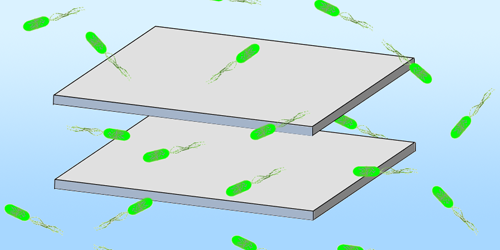Far-Field Flow Forces Attraction
Long-range attraction between distant objects can arise from gravitational or electrostatic forces. For objects suspended in active fluids—those containing a large number of tiny motile particles—efforts to understand how these forces drive effective interactions focus on direct collisions between the objects and the active agents. Now Luhui Ning and Yi Peng of the Chinese Academy of Sciences and their colleagues show that indirect effects can also play an important role in generating long-range attraction [1]. By examining the effective interactions between two plates immersed in a bacterial suspension, they show that hydrodynamic forces generated by swimming bacteria have a strong influence on the plates’ behaviors. The results open a new pathway toward developing active fluids to manipulate interactions between passive objects, a common objective in biomedicine and materials science.
Ning, Peng, and their team made suspensions of E. coli—3-µm-long, rod-shaped bacteria—in water, at volume fractions ranging from 0.05 to 0.13. Using optical tweezers, they trapped two plastic plates, 20 µm long and 7.5 µm thick, arranged so that they faced one another at a distance of 10 to 30 µm. Then they recorded the positions of the plates and the swimming bacteria over 4-minute intervals.
The measurements showed that the plates experienced a long-range attraction that increased linearly with bacterial concentration and decreased with plate separation. Numerical simulations confirmed that it was not direct bacterium–plate collisions that drove this attraction but bacteria-induced motion of the water.
The researchers say that their results highlight the importance of hydrodynamics on the effective forces between passive objects in active-matter baths. This finding could be exploited to design activity-driven assembly and transportation of objects in fluid media.
–Rachel Berkowitz
Rachel Berkowitz is a Corresponding Editor for Physics Magazine based in Vancouver, Canada.
References
- L. Ning et al., “Hydrodynamics-induced long-range attraction between plates in bacterial suspensions,” Phys. Rev. Lett. 131, 158301 (2023).




